WELLFLEET — When Robert Rindler was a young boy, he collected baseball cards. But unlike his brother, he wasn’t so concerned about the players: he was in it for the hats. “I cut out all the hats and sorted them: all the red hats, all the blue hats,” he says.
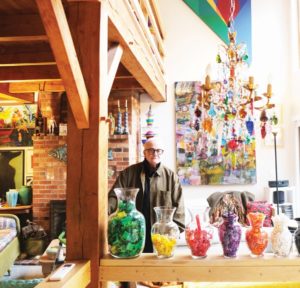
The practice — and its central idea — has remained with him as an artist, collector, and curator. “The content of what the thing is by itself is not as important to me as the context in which it exists or I put together,” says Rindler, who is known locally as both an artist and a champion of other artists through the lecture series he leads each year in the Open University of Wellfleet and as the curator of an ambitious exhibition program at the Wellfleet Adult Community Center.
His home, which he shares with his husband, James Connors, is perhaps his most carefully considered context for a dizzying number of collections reflecting a lifelong obsession with colorful objects.
At this time of year, Rindler’s kitchen table is half covered by a collection of glass Christmas trees. In his living room, he arranged toy parts in groups of solid colors, each contained in glass vases lining a railing. The walls are covered in art from floor to ceiling. On one wall, shades of green harmonize in a group of four paintings — a democratic mix including one piece by Cecily Brown and another he bought from an art student. (Previously, Rindler was the dean of Cooper Union in New York City.) Above the ground floor, all the artwork along the home’s central stairway is hung in white frames. Below the ground floor, all the frames are black.

“I’m interested in taking something chaotic and making it ordered,” says Rindler. Taken together, the sheer amount of stuff in his home is a recipe for chaos. But in his hands, it becomes a neatly portioned visual feast.
In addition to the over-the-top installation at his home, Rindler also creates individual art pieces. He has two works on display in the Provincetown Art Association and Museum’s current members’ juried exhibition and small works exhibition.
One piece, Final Forest, is a collection of 16 tree-like forms created from toy parts found at the Wellfleet swap shop. The parts — which include sippy cups, green plastic leaves, and a neon orange bowling pin — are stacked atop each other and appear to grow upward like some synthetic fungi, each crowned with a different ball.
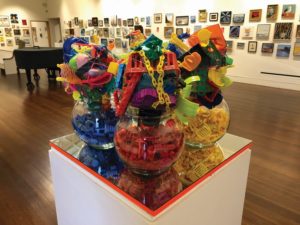
Rindler has been obsessively collecting these toy parts since he moved to Wellfleet 30 years ago. “There are a lot of grandparents here,” he says. “When their grandchildren come, they buy cheap plastic things at the dollar store. Then the kids go away, and they either throw it away or bring it to the swap shop.” That’s when Rindler swoops in, collecting only solid color toys and carefully washing each piece before transforming them into works of art.
When Rindler considers creating new forms from his swap shop gleanings, he relies on notions of form and color he developed as a student of architecture and design.
“Almost everything I do deals with the grid in some way,” he says. In his 2012 solo exhibition at PAAM, he arranged toy parts — separated by color, of course — in a patchwork of large rectangles, which simultaneously ordered the objects and presented them as raw material, not unlike the way an abstract painter might work with a grid or a rectangle as an armature to explore the material properties of paint. And just as an abstract painter is unconcerned with representation, Rindler avoids creating easily readable objects.
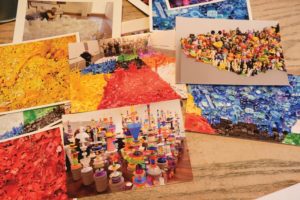
“Sometimes I’ll say they’re flowers, but it’s not really that important to me,” he says. He prefers that they read abstractly as “a pile of stuff.”
“I’m interested in the definition of design as an order,” he adds. “It’s ordering something, whether it’s by type or color.” In addition to imposing order through geometry, he often uses type as the organizing principle, as he does in a work he created from doll hairbrushes or in his piece A Tsunami of Male Miniquins, a collection of 10,000 male figurines.
“The boys are always stupid or funny,” he says of the toys. “Being a gay man, I became obsessed with how maleness is represented.”
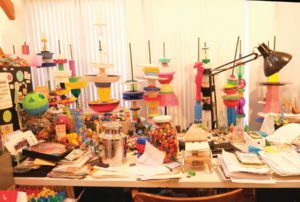
He’s also obsessed with rainbows — “long before it became a gay icon,” he claims. “There’s just something about the spectrum that has always completely engaged me.” He attributes some of his inspiration to the early 20th-century Dutch art movement De Stijl, which favored simple compositions and generally used only black, white, and primary colors.
Despite all the bright colors and playful materials, Rindler says that his real concern is to be taken seriously. Environmental peril is the dark truth under the candy-colored surface of these objects. In Four Bubbling Double Boilers, currently on view at PAAM, the imposed order of the grid and the monochromatic bases feels threatened by the explosion of toys erupting outward.
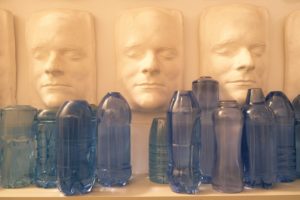
“People don’t realize you can’t really dispose of plastic,” he says. “It doesn’t break down. It’s there forever. But I don’t like to proselytize. I don’t try to act like I’m environmentally more sensitive or informed than anyone else. I really want the seriousness of it to come through.”



